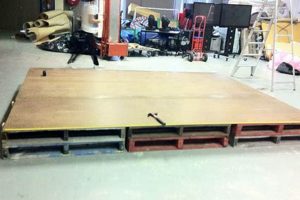Constructing bicycle storage solutions using timber as the primary material allows for customization and cost-effectiveness. These structures, often designed and built by individuals, range from simple leaning racks to more elaborate, freestanding designs. An example is a rack built from pressure-treated lumber featuring slots to hold multiple bicycles upright.
The appeal of these handcrafted storage options lies in their adaptability to specific needs and available space. They offer a potentially less expensive alternative to commercially manufactured metal racks, and can be aesthetically integrated into a home’s exterior or garage. Historically, utilizing readily available timber for practical projects has been a common practice, reflecting resourcefulness and self-sufficiency.
The following sections will examine various designs for these timber-based storage solutions, detail necessary materials and tools, and provide step-by-step instructions for their construction.
Construction Tips for Timber Bicycle Storage
The following advice is intended to optimize the construction of robust and functional bicycle storage using lumber. Adherence to these guidelines will promote both structural integrity and longevity of the finished product.
Tip 1: Material Selection: Employ pressure-treated lumber for outdoor applications to resist rot and insect infestation. Consider redwood or cedar as naturally durable alternatives, although they may be more expensive.
Tip 2: Accurate Measurements: Prioritize precise measurements before cutting any timber. Inaccurate dimensions compromise the rack’s stability and ability to accommodate bicycles properly. Double-check all measurements against bicycle tire widths and frame sizes.
Tip 3: Secure Fasteners: Use galvanized or stainless-steel screws and bolts to prevent rust, especially in outdoor environments. Pre-drill pilot holes to avoid splitting the wood during assembly. Ensure fasteners are appropriately sized for the lumber’s thickness.
Tip 4: Stable Foundation: If building a freestanding rack, create a solid and level base. This might involve a concrete slab, pavers, or a frame resting on the ground. A stable base is crucial for preventing tipping and ensuring long-term stability.
Tip 5: Smooth Finish: Sand all exposed edges and surfaces to prevent splinters and improve the overall appearance. Applying a sealant or stain further protects the timber from the elements and enhances its aesthetic appeal.
Tip 6: Consider Bicycle Dimensions: Account for variations in bicycle tire widths and frame geometries. Adjustable slots or wider spacing may be necessary to accommodate different types of bicycles.
Tip 7: Reinforce Joints: Use wood glue in addition to screws or bolts to strengthen joints. Angle brackets or gussets can provide additional reinforcement, especially at points of high stress.
Applying these suggestions during the construction phase can help yield a durable, functional, and aesthetically pleasing solution. The implementation of these guidelines minimizes potential structural weaknesses and maximizes the operational lifespan.
The succeeding portion of this document will address aspects of safety and maintenance concerning these timber-based storage structures.
1. Material Durability
The longevity and functionality of do-it-yourself timber bicycle racks are directly contingent upon the material’s inherent ability to resist degradation over time. The selection of inappropriate lumber invariably results in premature structural failure, rendering the storage solution ineffective and potentially hazardous. Cause-and-effect relationships are readily apparent; untreated softwood exposed to repeated moisture cycles will rot, leading to weakened joints and eventual collapse. Conversely, the implementation of durable materials, such as pressure-treated lumber or naturally rot-resistant species like cedar or redwood, significantly extends the service life of the rack. This correlation underscores the paramount importance of material durability in the context of timber bicycle rack construction. A practical example is a rack constructed from untreated pine collapsing within a single year due to fungal decay, in stark contrast to a similar rack fabricated from pressure-treated lumber remaining structurally sound after several years of exposure to the elements.
The practical significance of understanding material durability extends beyond simple longevity. A structurally sound rack ensures the safe and secure storage of bicycles, preventing damage to the bicycles themselves and mitigating potential injury resulting from rack failure. For instance, a rack built with insufficient attention to material selection could buckle under the weight of multiple bicycles, resulting in costly repairs or replacements. Furthermore, the environmental impact of frequently replacing deteriorated racks necessitates a focus on durable materials. The increased resource consumption and waste generation associated with short-lived structures are minimized by prioritizing long-lasting timber options.
In conclusion, material durability is a non-negotiable prerequisite for successful timber bicycle rack construction. The challenges associated with selecting appropriate materials are primarily economic, as durable options often incur higher initial costs. However, these costs are offset by the extended service life, reduced maintenance requirements, and enhanced safety provided by durable lumber. The broader theme of sustainable construction practices is directly linked to material durability; prioritizing long-lasting materials contributes to resource conservation and minimizes environmental impact.
2. Structural Design
Structural design forms a cornerstone of successful timber bicycle rack construction. The arrangement of lumber components dictates the rack’s ability to withstand applied loads and maintain its intended form over time. Inadequate structural design leads to instability, reduced weight capacity, and a heightened risk of failure. A common example involves racks with insufficient bracing; these designs are prone to swaying or collapsing under the weight of multiple bicycles. Conversely, a structurally sound design incorporates elements such as triangulation, cross-bracing, and appropriately sized lumber to distribute weight and resist deformation. The direct consequence of poor structural design is a compromised rack, unable to safely and reliably store bicycles.
The importance of structural design extends beyond preventing immediate collapse. A well-designed rack maximizes space efficiency by providing optimal bicycle spacing and minimizing the overall footprint of the structure. Furthermore, careful consideration of structural principles can improve the rack’s aesthetic appeal and ease of use. For instance, designing the rack with an appropriate angle for bicycle support reduces the effort required to load and unload bicycles. Real-world examples demonstrate the practical significance of this understanding; commercially available bicycle racks often incorporate advanced structural design elements to achieve a balance between strength, weight, and visual appeal. A frame that has an angle leaning too much can result to an imbalance. A frame with a right angle can result to a hard time to load and unload a bicycle.
In conclusion, structural design is an indispensable element of timber bicycle rack construction. The challenges primarily reside in acquiring the necessary engineering knowledge and applying it effectively in a practical setting. However, the benefits of a well-designed rack including enhanced safety, increased longevity, and improved usability far outweigh the initial investment in design expertise. The theme of responsible construction is intrinsically linked to structural design; prioritizing sound engineering principles contributes to the creation of durable and safe storage solutions, therefore it has to have an effective angle where bicycles can lean effectively without falling or imbalance.
3. Joint Strength
Joint strength represents a critical determinant of the overall structural integrity and load-bearing capacity in timber bicycle racks. The junctions where lumber components connect are inherently vulnerable points of stress concentration. Consequently, the method and execution of these connections profoundly influence the rack’s resistance to deformation and potential failure under load. Deficient joint strength manifests as racking, loosening, or complete separation of components, rendering the storage solution unsafe and ineffective. A rack constructed with poorly executed butt joints, for instance, lacks the requisite resistance to shear forces, particularly under the dynamic loads imposed by bicycle placement and removal. Conversely, the implementation of robust jointing techniques, such as mortise-and-tenon joints, dovetail joints, or reinforced screw connections with adhesive, significantly enhances the rack’s structural resilience. A visible cause-and-effect relationship exists: inadequate joinery precipitates premature failure, while strong, well-executed joints extend the rack’s service life.
The importance of joint strength extends beyond mere structural stability. Secure and durable joints contribute directly to user safety. A rack with compromised joints poses a significant hazard, as bicycles may unexpectedly fall, potentially causing damage or injury. Furthermore, robust joinery enhances the aesthetic quality and longevity of the storage solution. A rack built with meticulous attention to joint detail exudes a sense of craftsmanship and is more likely to withstand the rigors of prolonged use. In practical applications, the selection of appropriate jointing techniques depends on factors such as the type of lumber, the anticipated load, and the desired aesthetic. A simple rack designed for light-duty use may suffice with reinforced screw connections, while a heavier-duty rack necessitates the use of more complex and robust joinery methods. The choice of joint can affect a person’s safety.
In conclusion, joint strength is an indispensable element in the design and construction of timber bicycle racks. The challenges primarily stem from the requirement for woodworking skill and a thorough understanding of structural mechanics. However, the benefits of strong, reliable joints include enhanced safety, increased durability, and improved aesthetic appeal. The broader theme of responsible construction is directly related to joint strength, and it is important to consider the effect on safety. Prioritizing robust joinery methods contributes to the creation of a long-lasting and safe storage solution.
4. Weight Capacity
Weight capacity represents a paramount consideration in the design and construction of timber bicycle racks. This parameter dictates the maximum load the structure can safely bear, directly impacting its suitability for accommodating varying numbers and types of bicycles.
- Material Selection and Load-Bearing Capabilities
The choice of lumber species and dimensions significantly influences the rack’s weight capacity. Dense hardwoods, such as oak or maple, exhibit superior load-bearing capabilities compared to softwoods like pine or fir. Similarly, increasing the thickness and width of the lumber enhances its resistance to bending and deflection under load. For example, a rack constructed from 2×4 pine lumber will possess a lower weight capacity than a rack constructed from 4×4 oak lumber.
- Joint Strength and Load Distribution
The integrity of the joints plays a crucial role in distributing the applied load across the rack’s structure. Weak or poorly executed joints become points of stress concentration, potentially leading to premature failure. Employing robust joinery techniques, such as mortise-and-tenon joints or reinforced screw connections with adhesive, enhances the overall weight capacity. The efficient distribution of weight across the rack’s frame minimizes stress on individual components, thereby maximizing the load-bearing capabilities.
- Structural Design and Support Configuration
The overall structural design directly impacts the rack’s ability to withstand load. Designs incorporating triangulation, cross-bracing, or gussets provide additional support and enhance the rack’s resistance to deformation. The placement and spacing of supports influence the distribution of weight and prevent excessive bending of horizontal members. For example, a rack with widely spaced supports will be more prone to sagging under load than a rack with closely spaced supports.
- Safety Factors and Over-Engineering Considerations
Incorporating a safety factor into the design process is essential for ensuring structural integrity and preventing catastrophic failure. This involves over-engineering the rack to withstand loads exceeding the anticipated maximum weight. A safety factor accounts for variations in material properties, construction quality, and unforeseen stresses. For example, designing a rack to withstand twice the expected maximum load provides a margin of safety and reduces the risk of failure.
The facets of material selection, joint strength, structural design, and safety factors collectively determine the weight capacity of these storage structures. Careful consideration of these elements is paramount for constructing a safe, reliable, and durable solution capable of accommodating the intended number and types of bicycles. Failure to adequately address these factors can result in structural failure, potentially causing damage to bicycles or injury to individuals.
5. Weather Resistance
The durability and longevity of a timber bicycle rack intended for outdoor use are inextricably linked to its resistance to environmental factors. Moisture, sunlight (specifically ultraviolet radiation), temperature fluctuations, and biological organisms collectively pose significant threats to wood, leading to degradation and eventual structural failure. The ingress of moisture promotes fungal decay, weakening the wood fibers and compromising the rack’s load-bearing capacity. Prolonged exposure to ultraviolet radiation causes surface degradation, resulting in discoloration, cracking, and loss of structural integrity. Temperature fluctuations induce expansion and contraction, creating stress within the wood and potentially leading to joint failure. These effects, if unmitigated, directly reduce the lifespan and functionality of the structure. For instance, an untreated pine rack left exposed to the elements can deteriorate within a year, rendering it unusable.
The incorporation of weather-resistant materials and construction techniques is paramount for mitigating these detrimental effects. Pressure-treated lumber, impregnated with chemical preservatives, provides enhanced protection against fungal decay and insect infestation. The application of water-repellent sealants and paints creates a barrier against moisture penetration, preventing water absorption and minimizing the risk of rot. Utilizing exterior-grade fasteners, such as galvanized or stainless-steel screws and bolts, prevents corrosion and ensures long-term structural integrity. Constructing the rack with appropriate drainage allows water to escape, minimizing the risk of standing moisture. Design choices are also important. For example, elevating the rack off the ground on concrete blocks or pavers prevents direct contact with damp soil, further reducing the risk of decay. The selection of durable materials, combined with sound construction practices, significantly enhances the rack’s weather resistance, resulting in a more robust and long-lasting storage solution. A frame that is built from an unstable wood can result to an easily broken storage.
In summary, weather resistance is a non-negotiable requirement for timber bicycle racks intended for outdoor use. The challenges primarily involve the selection of appropriate materials and the implementation of proper construction techniques. However, the benefits of a weather-resistant rack including increased longevity, reduced maintenance, and enhanced safety outweigh the initial investment. The broader theme of sustainability is closely linked to weather resistance; prioritizing durable materials and construction methods reduces the need for frequent replacements, minimizing resource consumption and environmental impact. These racks are more durable for an extended period of time, requiring little to no attention.
6. Bicycle Compatibility
The design and construction of timber bicycle racks necessitate careful consideration of bicycle compatibility. The variety of bicycle types, frame geometries, and tire widths demands a flexible design approach to ensure secure and damage-free storage. A rack designed solely for road bikes, for example, may prove inadequate for accommodating mountain bikes with wider tires or bicycles with step-through frames. The consequence of neglecting this aspect is a rack that fails to securely hold certain bicycles, leading to potential damage to the bicycles themselves or creating a safety hazard. In practical terms, a narrow slot designed for road bike tires can be insufficient to hold a mountain bike tire, resulting in an unstable and potentially dangerous situation. The importance of this is extremely high, because if bicycle cannot be loaded to frame, it is basically useless.
Addressing bicycle compatibility requires incorporating adjustable or multi-sized slots, wider spacing between bicycles, or adaptable support mechanisms. Racks designed with adjustable slots can accommodate a wider range of tire widths. Similarly, incorporating varied slot heights or adaptable support arms can accommodate different frame geometries. Real-world examples include racks featuring slots designed to accommodate both narrow road bike tires and wider mountain bike tires. Other designs incorporate a U-shaped bar to support bicycles, accommodating various frame types. The consideration of multiple types of bicycles is a must.
In conclusion, bicycle compatibility is a critical design consideration for timber bicycle racks. The challenges mainly involve anticipating the diverse range of bicycles that the rack will need to accommodate and incorporating the necessary design features. However, the benefits of a compatible rack enhanced usability and safety, outweigh the design and construction considerations. The broader theme of user-centered design is directly linked to bicycle compatibility; prioritizing the needs of diverse bicycle users results in a more functional and accessible storage solution.
7. Safety Considerations
Safety is paramount in the construction and use of timber bicycle racks. These structures, if improperly designed or constructed, pose risks ranging from minor bicycle damage to significant personal injury. The following facets detail critical safety considerations relevant to do-it-yourself timber bicycle storage solutions.
- Structural Integrity and Load Capacity
Ensuring the rack can support the intended weight is crucial. Overloading leads to structural failure, posing a direct hazard. Thoroughly evaluate the load-bearing capabilities of the selected lumber and joinery methods. For instance, a rack designed for two bicycles must not be used to store four, regardless of initial appearances of stability. Regular inspection for signs of stress, such as bending or cracking, is necessary.
- Stability and Tip-Over Prevention
A stable base prevents accidental tipping, especially in outdoor environments or areas with uneven surfaces. A wide base, anchoring mechanisms, or weighting can enhance stability. A rack placed on a sloped surface requires additional stabilization to prevent it from becoming a safety hazard. Wind can also be a factor in whether the rack stays stable. Weight can also add to the stabilization.
- Material Hazards and Surface Finish
Untreated lumber can splinter, posing a laceration risk. Sharp edges or protruding fasteners create additional hazards. Sanding surfaces and applying a sealant or paint mitigates these risks. The sealant also helps it to be weather resistant. Regular inspection can prevent hazard before it even starts.
- Placement and Accessibility
The rack’s location should not obstruct walkways, driveways, or emergency exits. Adequate clearance around the rack is necessary for safe bicycle loading and unloading. A rack placed in a high-traffic area must be positioned to minimize the risk of collisions. Proper planning ahead of time is important for all safety considerations.
These safety considerations are integral to responsible construction. Prioritizing these aspects minimizes the potential for accidents and ensures a safe and functional storage solution. Neglecting these elements compromises the rack’s utility and introduces unacceptable risks. Regular inspection is encouraged.
Frequently Asked Questions
The following addresses common inquiries regarding the construction and utilization of bicycle storage solutions employing timber as the primary material.
Question 1: What lumber type offers the optimal balance between cost-effectiveness and durability for outdoor bicycle racks?
Pressure-treated lumber provides a suitable compromise, offering resistance to rot and insect infestation at a comparatively moderate cost. While naturally durable species such as redwood and cedar offer superior longevity, their higher price point may be prohibitive for some budgets.
Question 2: How can premature decay be prevented in timber racks exposed to inclement weather?
Applying a water-repellent sealant or paint provides a protective barrier against moisture penetration. Regular reapplication, typically annually or bi-annually, maintains the wood’s resistance to water absorption.
Question 3: What are the primary considerations regarding joint selection and construction for structural stability?
Joints should be designed to withstand anticipated loads and stresses. Employing robust techniques such as mortise-and-tenon joints or reinforced screw connections with adhesive enhances structural integrity. Proper execution is paramount; ensure accurate alignment and secure fastening.
Question 4: How can a timber bicycle rack be secured to prevent theft or vandalism?
Anchoring the rack to a solid surface, such as a concrete slab, using appropriate hardware deters theft. Furthermore, utilizing locking mechanisms that secure bicycles to the rack provides an additional layer of protection.
Question 5: What are the primary safety concerns associated with timber racks, and how can these concerns be mitigated?
Potential hazards include structural failure, sharp edges, and unstable footing. Adhering to sound construction principles, sanding surfaces to eliminate splinters, and ensuring a level and secure base minimizes these risks.
Question 6: How can diverse bicycle types and sizes be accommodated within a single timber rack design?
Incorporating adjustable slots or varying slot widths allows for greater flexibility in accommodating different tire sizes and frame geometries. Designing the rack with sufficient spacing between bicycles prevents interference and ensures ease of use.
The foregoing underscores the importance of careful planning and execution in creating functional and safe bicycle storage. The correct type of lumber is important for construction.
The succeeding section will offer a collection of design blueprints for the aforementioned.
Conclusion
The preceding analysis has explored fundamental aspects of “diy bike rack wood,” encompassing material selection, structural design, joint strength, weather resistance, bicycle compatibility, and safety considerations. The effective integration of these elements dictates the ultimate functionality, longevity, and safety of the resulting structure.
Responsible construction necessitates a thorough understanding of these principles. The successful implementation of these considerations contributes to the creation of durable, reliable, and safe storage solutions, extending beyond mere cost savings to promote responsible resource utilization and user well-being. The information delivered is not all, consider learning more about woodworking skills for extra skills and abilities to contribute to the project.



![[DIY Guide] Easy DIY Wood Window Shutters You Can Build! The DIY Hub: Creative Crafts, Repairs & Life Hacks [DIY Guide] Easy DIY Wood Window Shutters You Can Build! | The DIY Hub: Creative Crafts, Repairs & Life Hacks](https://craftingdiycenter.com/wp-content/uploads/2025/07/th-3579-300x200.jpg)



